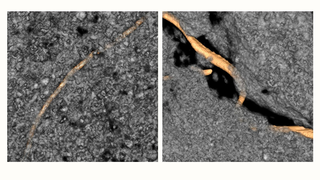The root of the matter: soil structure’s effect on root growth and carbon storage

Looking at two plant species and two different soils, this study investigated how the structure of soil can inhibit or advance root growth and carbon sequestration belowground.
The Science
Plant roots play an under-recognized role in trapping carbon in the soil. Plants remove carbon from the air through photosynthesis and use their roots to deposit it in the soil. Different sized pores dictate the transport of nutrients and water within the soil. This study tests whether the structure of soil affects how plant roots grow and distribute carbon. The study concluded that, for some plants, soil structure plays a pivotal role in determining how their roots will grow and how long the carbon transported from the plants will remain in the soil.
The Impact
Soil presents a huge opportunity to remove carbon dioxide from the atmosphere and store it underground. However, a lot of the carbon stored in the soil is eventually returned to the air. Because climate change is primarily driven by atmospheric carbon dioxide it’s critical to examine how and why plants choose to optimize the amount of carbon they release into the soil. Comparing switchgrass and black-eyed Susan, this study found that higher contact between root and soil increases the release of carbon from plants to the soil. Though higher root-soil contact also leads to more carbon released into the atmosphere, the increased root-soil contact will eventually start to insulate the carbon underground.
Summary
Researchers with the Great Lakes Bioenergy Research Center compared the root growth of two plant species: Rudbeckia hirta (black-eyed Susan) and Pancium virgatum (switchgrass) in switchgrass and prairie soils. Each soil was further separated into sieved and intact samples. Because sieving the soil disrupts its natural pore structure, the experiment measured the effect of soil structure on root growth. Researchers placed all four soil types separated by perforated material into single pots separated into cylinders. Researchers planted either switchgrass or black-eyed Susan in each pot. With the help of X-ray CT scans of the soils, they could study how the root systems grew into the four soil types: sieved switchgrass, intact switchgrass, sieved prairie, and intact prairie.
Each plant was fed carbon dioxide “labeled” with a radioactive carbon isotope, allowing researchers to track the amount of carbon working its way into the soil surrounding the plants.
After harvesting the roots, the researchers found that black-eyed Susan’s roots adapted to the different environments and maintained high root-soil contact regardless of the soil structure its roots encountered. When switchgrass grew into either sieved soil or its own soil, it preferred to follow old root pathways in larger soil pores. Because its roots grew inside larger soil pores, its root-soil contact decreased and so did its carbon output. In intact prairie soil, however, switchgrass grew into denser soil structures.
Contact
Maik Lucas
Technical University of Berlin
ml@tu-berlin.de